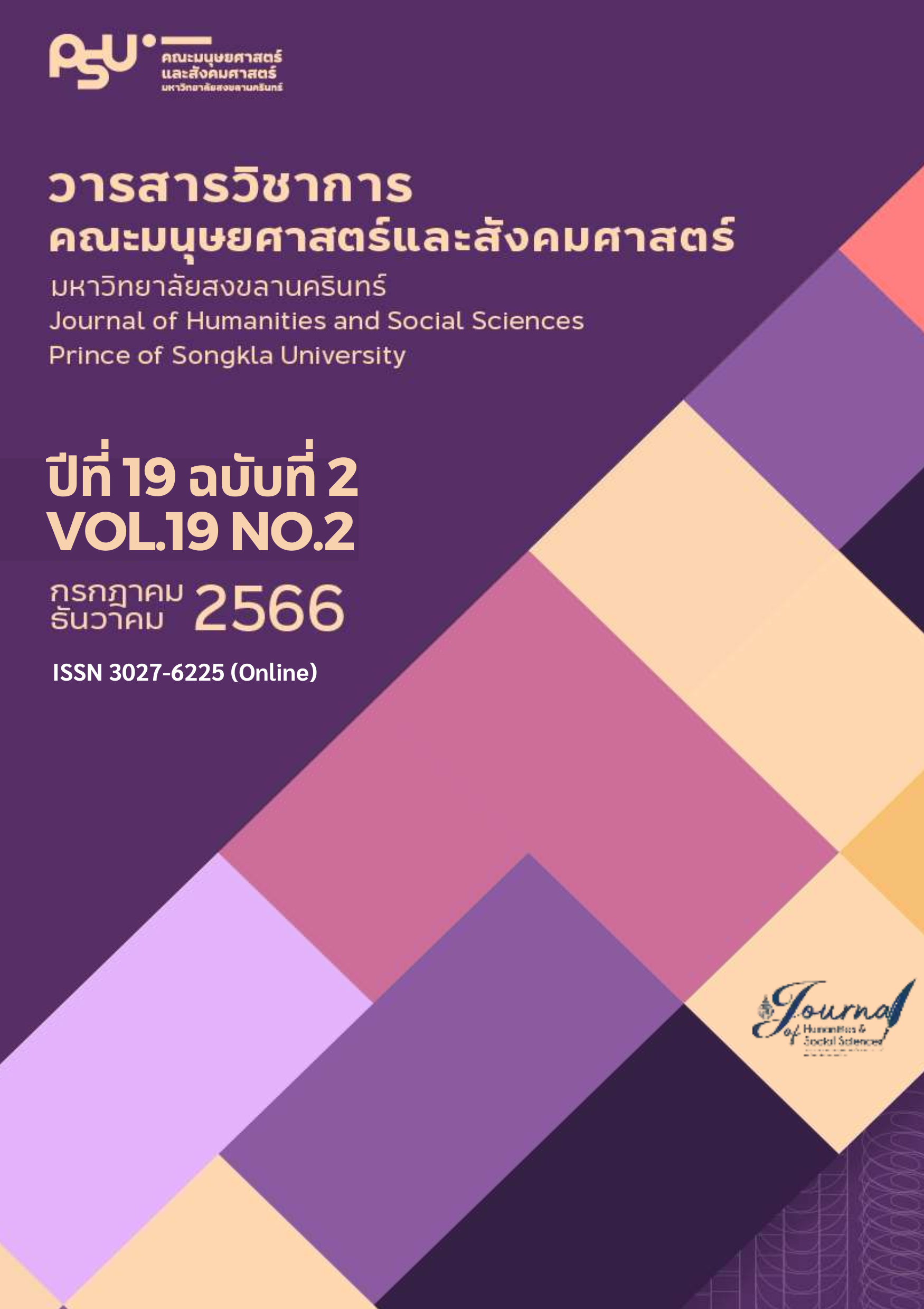The Translation of Onomatopoeic Words in Nick McDonell’s The Council of Animals
Keywords:
Onomatopoeia, Translation, Translation techniques, English-Thai, equivalentAbstract
This article aims at exploring techniques used in translating onomatopoeias and applying them to the English-to-Thai translation of these words in Nick McDonell’s The Council of Animals (2021), which features animals as the main characters. The study reveals that the translation techniques that work best with onomatopoeic words include the selection of target-text equivalents, which is found to be the most frequent option in the literature. This technique can be complemented by phonological means (e.g. addition of tone markers to increase pitch, or extra final consonants to lengthen the syllable) and transliteration. Creating a new onomatopoeic word through phonological means, as well as opting for loan words or transliteration are possible solutions. Omission, however, is deemed inappropriate in all cases as it will result in the loss of expressivity in the target text.
References
ณัฏฐิรา ทับทิม. (2556). การศึกษาวิธีการและประเภทการแปลคำเลียนเสียงธรรมชาติและคำบอกอาการ หรือสภาพจากภาษาญี่ปุ่นเป็นภาษาไทย. วารสารญี่ปุ่นศึกษาธรรมศาสตร์, 30(1), 41-57. https://so02.tci-thaijo.org/index.php/japanese/article/view/13578
พจนานุกรมฉบับราชบัณฑิตยสถาน พ.ศ. ๒๕๕๔. (ม.ป.ป.). https://dictionary.orst.go.th/
พจนานุกรมฉบับมติชน. (2547). มติชน.
วรรณา แสงอร่ามเรือง. (2563). ทฤษฎีและหลักการแปล. (พิมพ์ครั้งที่ 4). สำนักพิมพ์จุฬาลงกรณ์มหาวิทยาลัย.
สรบุศย์ รุ่งโรจน์สุวรรณ. (2550). โครงการคำเลียนเสียงธรรมชาติในภาษาไทย : รายงานวิจัยฉบับสมบูรณ์. สำนักงานกองทุนสนับสนุนการวิจัย.
Akita, K. (2013). Constraints on the semantic extension of onomatopoeia. Public Journal of Semiotics, 5(1), 21-37. https://doi.org/https://doi.org/10.37693/pjos.2013.5.9646
Azari, R., & Sharififar, M. (2017). Translating onomatopoeia: An attempt toward translation strategies. Review of Applied Linguistics Research, 3(3), 72-92.
Baker, M. (2011). In Other Words: A Coursebook on Translation. Routledge.
Cambridge Advanced Learner’s Dictionary and Thesaurus (4th edition). (2013). Cambridge University Press & Assessment. from https://dictionary.cambridge.org/dictionary/english/
Casas-Tost, H. (2014). Translating onomatopoeia from Chinese into Spanish: a corpus-based analysis. Perspectives, 22(1), 39-55. https://doi.org/10.1080/0907676X.2012.712144
Collins English Dictionary. (2020). https://www.collinsdictionary.com/english/
Fillmore, C. J. (1977). Scenes-and-frames semantics. In Zampolli, A. (Ed.). Linguistic Structures Processing. North Holland Publishing Company.
Flyxe, M. (2002). Translation of Japanese onomatopoeia into Swedish (with focus on lexicalization). Africa & Asia, (2), 54-73.
Fromkin, V. Rodman, R. & Hyams, N. (2010). An Introduction to Language (9th edition). Wadsworth Cengage Learning.
Kakehi, H. (1993). Bungaku sakuhin ni mirareru onomatope hyôgen no nichi-eitaishô. In: H. Kakehi and I. Tamori (Eds.), Onomatopia: gion, gitaigo norakuen (pp. 127-143). Keisô Shobô.
Inose, H. (2008). Translating Japanese onomatopoeia and mimetic words. In A. Pym & A. Perekrestenko (Eds.), Translation project 1 (pp. 97-116). Intercultureal Studies Group. https://www.intercultural.urv.cat/media/upload/domain_317/arxius/TP1/InoseOnomatopoeia.pdf
McDonell, N. (2021). The Council of Animals. Henry Holt and Co.
Merriam-Webster Online Dictionary. (n.d.). https://www.merriam-webster.com/dictionary
Muhaidat, F. M. (2009). A Tale of Two cities in Arabic Translation. [Doctoral dissertation, Binghamton University].
Pinker, S. (1994). The Language Instinct. W. Morrow and Co.
Pischedda, P. S. (2011). A Corpus-Based Study on the Translation of English Ideophones in Italian Picture Books: The Case of the Diary of a Wimpy Kid. Languages, 7(3), 224-237.
Sasamoto, R. (2019). Onomatopoeia and Relevance. Palgrave Macmillan Cham.
Sharifi Moghadam, A., & Ghazizade, A. (2016). Translation of onomatopoeia in holy defense literary works. Review of Applied Linguistics Research, 2(2), 101-116.
Simpson, P. (2014). Stylistics: A Resource Book for Students (2nd edition). Routledge.
Snell-Hornby, M. (2011). Of catfish and blue bananas: Scenes-and-Frames semantics as a contrastive “knowledge system” for translation. In H. V. Dam, J. Engberg, J. and H. Gerzymisch-Arbogast (Eds.) Knowledge Systems and Translation (pp. 193-206). De Gruyter Mouton.
Sugahara, T. (2011). Onomatopoeia in Spoken and Written English: Corpus- and Usage-based Analysis [Doctoral dissertation, Hokkaido University]. https://eprints.lib.hokudai.ac.jp/dspace/bitstream/2115/45138/1/Dissertation%20by%20Takashi%20SUGAHARA.pdf
Tamori, I. & Schourup, L. (1999) Onomatope: Keitai-to imi [Onomatopoeia: Morphology and Semantics. Kurosio Publishers.
Tiwiyanti, L. (2017). An Analysis on Onomatopoeic Words and their Translation Procedures in Harry Potter and The Prisoner of Azkaban and Its Translation Version. Scope Journal of English Language Teaching, 1(1), 39-48. https://doi.org/10.30998/scope.v1i01.870
Toratani, K. (2009). Translating mimetics in Japanese: a cognitive approach. New voices in Translation Studies, 5, 63-77.
Vannerem, M. & Snell-Hornby, M. (1986). Die Szene hinter dem Text: ‘Scenes-and-Frames Semantics’ in de Ubersetzung. In: M. Snell-Hornby (ed.), Übersetzungswissenschaft – eine Neuorientierung: Zur Integrierung von Theorie und Praxis (pp. 184–205). Francke.
Zanetic, F. (2015). Scenes-and-Frames Semantics [Seminar, University of Zadar]. https://www.academia.edu/21459510/Scenes_and_Frames_Semantics
Downloads
Published
How to Cite
Issue
Section
License
Copyright (c) 2023 Journal of Humanities and Social Sciences Prince of Songkla University

This work is licensed under a Creative Commons Attribution-NonCommercial-NoDerivatives 4.0 International License.
บทความนี้ได้รับการตีพิมพ์เป็นของวารสารวิชาการคณะมนุษยศาสตร์และสังคมศาสตร์ คณะมนุษยศาสตร์และสังคมศาสตร์ มหาวิทยาลัยสงขลานครินทร์ วิทยาเขตปัตตานี






